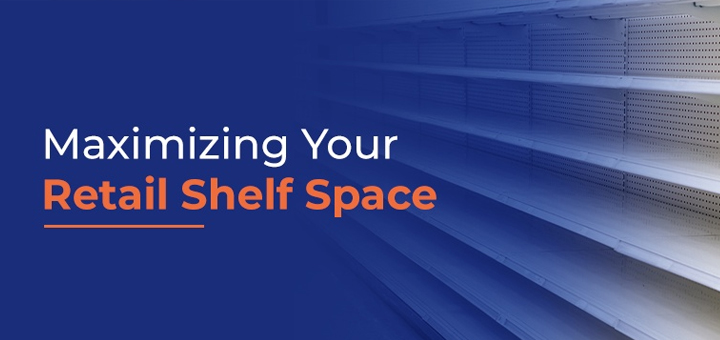Shelf space is valuable real estate in the retail environment. Brands need the ideal placement to stand out in a busy aisle where every adjacent product is a direct competitor. Shelves directly in customers’ sightline are usually the best spot for increasing sales. Some brands may also position their products for success on the upper or lower shelves.
Retailers weigh many factors when deciding which merchandise to shelve in specific locations. This practice is called shelf space management. Brands must recognize their retailers’ needs and gain prominent locations in stores. As retail packaging experts, QPSI understands retailers’ requirements and can help your brand leverage attractive, retail-ready packaging to earn more & better shelf space.
HOW ESSENTIAL ARE RETAIL PACKAGING AND SHELF SPACE?
Retail packaging and shelf placement are two critical factors in convincing a consumer to buy a product. Attractive, noticeable packaging helps customers see your merchandise, and so does a central placement at eye level. A more substantial shelf section with more items facing the aisle also helps them stand out. Meanwhile, the package’s branding communicates the type of product and who it is best for. All these factors are crucial for a consumer packaged goods brand trying to win customers.
A recent Nielsen study also observed that shoppers’ sightlines naturally gravitate about 15 to 30 degrees below the height of their eyes. Shoppers tend to see and grab items at waist level first. This is why it’s best to place your item slightly below eye level. Meanwhile, products’ sheer volume makes them noticeable. More facings give merchandise a weightier presence. Increasing a product’s share of visual inventory, or the percentage of facings, it takes up within the category, a.k.a. more shelf space, significantly impacts sales.
HOW RETAIL STORES PRIORITIZE SHELF SPACE
Maximizing retail shelf space for your products requires a thorough understanding of how stores plan their shelf placement. With that understanding, you can develop a successful retail shelf positioning strategy. Retailers generally place merchandise with higher margins and higher turnover at or around eye level. They also factor in accessibility and ease of location, product groupings and the flow of in-store traffic. Retailers have three main goals in shelf space management.
- To improve operational efficiency through stronger sales numbers and better inventory management.
- To enhance the shopping experience through an intuitive store layout.
- To prevent customer injuries and product damage through strategic placement of heavy and fragile items.
Fundamentally, retailers divide their shelf space into the top, middle and bottom shelves. To maximize profitability, those shelves each hold different products. Here’s how most retailers divvy up their shelf space.
- Top shelves: Shoppers associate the upper shelves with premium, higher-quality or niche merchandise, which retailers dub “curiosity” products. Retailers place high-profit, low-volume items in these sections.
- Middle shelves: The waist-level area is the prime shelving location where shoppers look first. Retailers prioritize their high-profit, high-volume sales items here and focus on keeping these shelves well-stocked. Placing strategic products in the most visible location maximizes the category’s profitability.
- Bottom shelves: This section is the least visible area. Stores place low-profit, mass-appeal products with high rotation on the bottom shelves. Since these shelves usually have more depth and can hold extra merchandise, this placement helps prevent shortages. Heavy items are another priority for the bottom shelves since it’s safer to lift from a lower height.
Traditionally, retailers use a plan-o-gram to map shelf layouts for products. These diagrams provide an overview of shelf placement and how products are performing based on location. Retailers also use category management or shelf-space allocation and technology to manage the merchandise or assortment. Category management provides the framework for evaluating pricing, promotion, arrangement and selections to achieve an optimized product mix.
Software for category management enables retailers to strategically organize products into specific groups, such as health and beauty supplies, detergents or organic ingredients. Each group counts as a separate product category and runs like a mini business. Retailers can then monitor individual category sales and gross margins. This data helps them determine if a category contributes to the bottom line.
HOW CAN YOU WIN BETTER SHELF SPACE?
Once you understand how stores decide which products get the most prominent placement, it’s much easier to appeal to those retailers. As you enter negotiations for shelf placement, tailor your proposals around retailers’ goals and needs. Frame your arguments in terms of how your preferred placement will improve profitability for you both.
Here are a few tips for how to get better shelf space in retail.
Know Your Retailer
Every retailer is different. They appeal to specific customers and have a unique strategy for driving sales. Gaining prime shelf space at a club store differs from earning shelf space at a grocery store or a mass-market retailer.
When negotiating with a retailer for better placement, you must speak their language. Before your meeting, spend time researching the decision-makers you’ll talk to and the store’s overall goals and needs. Then, adapt your pitch appropriately. Demonstrate how your products and in-store marketing strategy help them achieve their goals.
Share Your Expertise and Support
Major retailers have thousands of stock-keeping units across many categories to contend with. They can’t be an expert on every product, and you wouldn’t want them to be. You are your product expert. You understand your target customers and have optimized your branding to attract them. Take charge of your merchandising strategy and offer your full support to retail partners.
When you furnish them with a complete marketing campaign and promotional resources, retailers are more likely to accept your shelf space proposal. They’ll know they can continue to work with you to boost sales for a long, prudent partnership.
Have Retail-Ready Packaging
While larger packaging commands more attention, your product packaging needs a carefully thought-out design to drive sales and retailer acceptance. Attractive, premium graphic and structural designs go a long way toward boosting sales.
Another significant opportunity for improvement lies in increasing product and package densities. One of the best ways to accomplish this is to “right-size” your packaging to eliminate wasted space and enable you to fit more products on the shelves. Today’s customers want to use and pay for their products — not the packaging.
Propose Creative In-Store Marketing
In-store displays, advertising, and signage have a proven ability to increase sales in the retail environment. Original, colorful, and eye-catching designs help products stand out from the regular shelving fixtures. They’re excellent for introducing and educating customers on new merchandise or improving sales for a brand’s mainstays. Well-designed retail display solutions like pallet displays, floor stands, power wings, and other promotional structures will give you a prominent, eye-catching placement for a few months. These creative tools can improve market penetration enough to earn you better placement on permanent shelving.
Maximize Out-of-Store Marketing
In-store marketing is fantastic for promoting impulse buys. Still, retailers rely on you to get plenty of customers through the door. The best customers walk into the store with your product on their shopping list. Plus, successful marketing and demand-generation strategies are good for your retail partnerships. When customers practically demand your product, retailers are happy to give you prime shelving placement.
One way to introduce your customers to a new brand or product is through direct-to-consumer samples, which can increase in-store sales. By distributing attractive trial-sized products to the right customers, more people will know about your brand and want to find it in stores.
Collect Convincing Data
Retailers like making data-backed decisions. Planning shelf placement is complicated and involves balancing many competing brands and needs to optimize sales. The more data you can provide, the more comfortable retailers will be with your desired shelf placement. Some data points to provide include:
- Sales revenue and forecasting.
- Consumer demographics.
- Results from previous marketing strategies.
- Past sales versus competitors’ sales.
- Current market share.
- Lift analysis from new sales channels and marketing strategies.
- Sales-impact data, including purchase frequency and basket size for customers exposed to marketing versus those who weren’t.
Optimize Logistics
While a lot goes into choosing shelf placement, retailers’ top concern is maximizing profits. One way to do this is to improve sales for a particular product. The other way is to reduce costs associated with that product.
Retailers who want to get the most from their shelf space look at the many factors that impact their profitability, including:
- Cost of logistics per cube for shipment to stores — including fuel and freight charges for transporting goods from the warehouse to the store.
- Cost of necessary packaging for storage, protection, and transport, such as secondary and tertiary packaging and pallets.
- Labor costs for stocking and replenishment.
- Costs for slow-selling, damaged or expired products.
- Shrinkage resulting from theft and pricing errors.
- Sales lost from stock outages.
- Restocking and returning picked goods that nobody purchased.
As a CPG manufacturer, you play a pivotal role in optimizing logistics costs. First, design packaging that lets you ship more products more affordably. It’s also helpful to select packaging options that let retailers quickly and easily restock shelves.
PACKAGE YOUR PRODUCTS WITH HELP FROM QPSI
When visibility and visual appeal are two of the most critical factors for driving sales in the retail landscape, great consumer packaging design is crucial. The packaging designers at QPSI account for retailer requirements, logistics, graphic appeal and promotional needs to help you win at retail, too.
If you’re interested in our retail packaging services, contact the team at QPSI today. We’ll optimize your packaging for shelf space and cost-effectiveness to maximize your profitability. We design all our retail packaging solutions based on tried-and-true retail market research.






